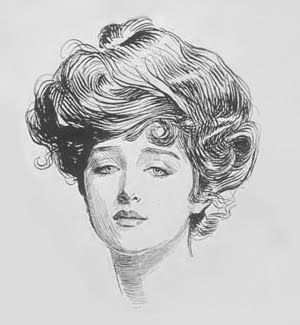I made this Lorna Doone costume for a costume ball. The top comes from a wedding gown pattern, I made the sleeve pattern, and a friend of mine made the skirt and over-skirt patterns.
The SkirtThe skirt is a circle skirt, which was cut out in two half's, the two half's were sewn together, and a standard waistband attached.
The Over SkirtThe over-skirt is made of two rectangles, one taller then the other.

The over layer of the over-skirt is made of silk essence, and is the taller rectangle. The under layer is made of fabric which matches the skirt. Both pieces are the same length. Both pieces are caught into one waistband, which is not as big as my waist. The over layer is sewn to the under layer at the bottom, and it is tacked about halfway down to the under layer, so as to be divided into two loops, a loop that extends from the waist band to about halfway down on the under layer, and a loop that extends from about halfway down on the under layer to the over-skirt's hem. There are ribbons attached to the ends of the waistband, these tie together to fasten the skirt around the waist.
The BlouseThe blouse was made from a fitted wedding dress pattern. I added squares of silk essence backed with skirt fabric to the bottom of my blouse for effect. You can see one in the picture below.

The sleeves were my own creation. For each sleeve I made a rectangle out of flat lace which was about a foot longer than my arm and about 20 inches wide. I hemmed one of the 20-inch sides, folded the rectangle in half width wise, and sewed it into a tube. I then made two loops of elastic, one of which fit snugly on my upper arm, and one of which fit snugly on my arm right above my elbow. I sewed this elastic onto the inside of the flat lace tube in appropriate places, so that when on my arm the flat lace ended at my wrist and the slack in the middle of the flat lace was divided evenly between two even sections, one of which covered from right above my elbow to my upper arm, and one of which covered my upper arm to my shoulder. I then gathered the top of the flat lace tube to fit the armhole. I next made strips of my dark green silk essence, which were about 30 inches long and 2 1/2 inches wide. I sewed them right sides together to some identical strips of fabric which matched the skirt, turned them inside out, and attached them to the sleeve, right on top of the bottom elastic band. I adjusted them so that they looped in a manner I liked from the bottom to the top band of elastic, and from the top band of elastic to the top of the flat lace tube. I cut off the excess strip that stuck out above the top of the flat lace tube. I tacked them right on top of the upper elastic band, and sewed the top of the flat lace tube into the armhole, with the strips sandwiched between the flat lace tube and the bodice.
This Costume is for sale at http://www.etsy.com/view_listing.php?listing_id=40321156













